For every script that makes it to the theatres – or even to video – a dozen crash and burn somewhere on the road. The reasons why are often impossible to discover. Movie studios are understandably reticent about their failures, not least because they tend to cost a lot more money than our screw-ups. However, these scripts often refuse to die, and a number have become public, whether from disgruntled writers or through studio interns.
Often, studios won’t give up on the central idea entirely – in two out of the three cases here, the movies were eventually made, and the remaining one is still possible. Obviously, any draft is likely to change en route to the screen, but for the examples here, new and radically different scripts were/will be commissioned. Barely the faintest trace of these proto-versions remain to be spotted, and that is what makes them so intriguing, since they provide a glimpse into what might have been…
George A. Romero: Resident Evil
“I just…never seen ’em comin’, Reddy. Never even…had a chance to…turn a gun on ’em.”
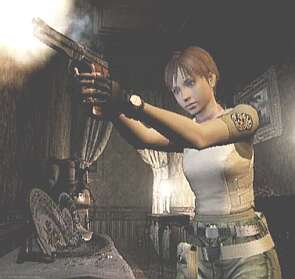 Romero is most – indeed, almost solely – famous for his trilogy, Night of the Living Dead, Dawn of the Dead, and Day of the Dead, so seemed ideal for a movie based on zombie slaughterthon Resident Evil. Brought on as writer/director after filming a Japanese commercial for the game, the script he came up with was rejected by the producers and he was dumped. According to Romero, “I don’t think they were into the spirit of the video game and wanted to make it more of a war movie.” After Steven Norrington (Blade) & Jamie Blanks (Urban Legend) were supposedly attached, the job eventually fell to Paul W.S. Anderson. His take was certainly more of an action flick than a zombie one, and probably also had less in common with the game itself [see elsewhere for our review] But what of Romero’s version?
Romero is most – indeed, almost solely – famous for his trilogy, Night of the Living Dead, Dawn of the Dead, and Day of the Dead, so seemed ideal for a movie based on zombie slaughterthon Resident Evil. Brought on as writer/director after filming a Japanese commercial for the game, the script he came up with was rejected by the producers and he was dumped. According to Romero, “I don’t think they were into the spirit of the video game and wanted to make it more of a war movie.” After Steven Norrington (Blade) & Jamie Blanks (Urban Legend) were supposedly attached, the job eventually fell to Paul W.S. Anderson. His take was certainly more of an action flick than a zombie one, and probably also had less in common with the game itself [see elsewhere for our review] But what of Romero’s version?
The main thrust – a mission to contain an outbreak of reanimating T-virus in an underground lab – is preserved, but the hero is male. Chris discovers that girlfriend Jill is part of an undercover military team, and through a (frankly implausible) series of events, ends up on the job as well. The rest of the team is the usual mix of heroes and villains, though “Rosie Rodriguez, a tough, body-built babe” suggests one too many viewings of Aliens.
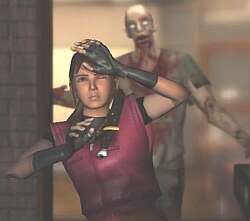 Romero’s problems are, as ever, plot and dialogue. Chris literally stumbles into a secret entrance, yet apparently played there as a child. Chris and Jill get one brief scene, are separated for 30 pages, then come perilously close to having a quickie between kills. Then there are speeches like, “They made you believe you were doing a good thing when it wasn’t good at all. It was evil! The kind of evil that resides in all of us. Makes us greedy, uncaring. The kind of evil that will wipe us out, in the end. Unless we stand up against it.”
Romero’s problems are, as ever, plot and dialogue. Chris literally stumbles into a secret entrance, yet apparently played there as a child. Chris and Jill get one brief scene, are separated for 30 pages, then come perilously close to having a quickie between kills. Then there are speeches like, “They made you believe you were doing a good thing when it wasn’t good at all. It was evil! The kind of evil that resides in all of us. Makes us greedy, uncaring. The kind of evil that will wipe us out, in the end. Unless we stand up against it.”
However, the pace is fast and the bio-organic weapons show good imagination – particularly the undead sharks, an idea first mooted in Lucio Fulci’s Zombie. There’s also intelligent, aggressive plants, a giant snake, and the pinnacle of research, the Tyrant, simply one bad mother which I’d really like to have seen on screen. It all ends in a hotly pursued dash out of the facility, similar to the eventual movie, though the very end owes a little to Return of the Living Dead.
That sort of thing means you can see why the producers felt deja vu – indeed, a character even says, “Christ, this is like Night of the Living Dead!” The emphasis is on the zombies; in particular, the dispatch thereof – you’d get more head shots from this film than pumping your ticket money into House of the Dead. I sense the intense, graphic violence would likely have displeased the MPAA, a group with which Romero has crossed swords in the past. Dog Soldiers covered similar “soldiers-in-peril” territory and showed the concept was not without promise, though I profess myself satisfied with the way Resident Evil eventually turned out, despite the cool monsters here. Maybe some ideas will eventually surface in Romero’s long-mooted fourth entry in the zombie series: Brunch of the Dead, anyone?
Daniel Waters: Catwoman
“Sanity to the wind, the large, now-eerily-shadowy lounge has been completely swallowed by the most multi-layered, full-throttle cat-fight in the history of cinema. The women totally communicate in cat-screeches, all human capabilities on hold.”
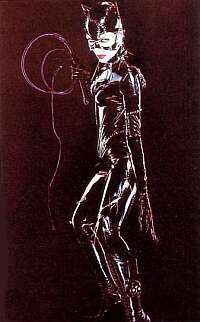 Daniel Waters’ career has been one of ups and downs. For every brilliantly-observed piece of satire, such as Heathers, there has been…well, Hudson Hawk. However, also on his resume is perhaps the best Dark Knight movie yet made, Batman Returns – though, let’s face it, with a supporting cast including Christopher Walken, Michelle Pfeiffer and Danny DeVito, a telephone directory would likely have made compelling viewing.
Daniel Waters’ career has been one of ups and downs. For every brilliantly-observed piece of satire, such as Heathers, there has been…well, Hudson Hawk. However, also on his resume is perhaps the best Dark Knight movie yet made, Batman Returns – though, let’s face it, with a supporting cast including Christopher Walken, Michelle Pfeiffer and Danny DeVito, a telephone directory would likely have made compelling viewing.
After that film’s success, a Catwoman feature was floated, and Waters wrote a script, dated June 16th, 1995, but it never made it into production. Waters seems to have bad luck like that; see also his The Model Daughter and adaptation of Stranger in a Strange Land. Or, rather, you can’t, as neither got made. Nobody seems to know for sure why Catwoman wasn’t produced, but Michelle Pfeiffer’s pregnancy around this time probably helped shove it onto the back burner. The departure of Burton from the franchise also dampened Pfeiffer’s interest.
Waters’ strength is parody through excess, and there’s something about the world he envisages which parallels the society in Demolition Man, except in reverse. While both enforce happiness on their inhabitants, San Angeles has erased violence in all its forms (at least until the arrival of Snipes and Stallone!), while Oasisburg has turned vigilantism into a spectator sport. The Cult of Good, led by Captain God, wipe the floor with criminals, to the cheers of an adoring crowd. However, they aren’t quite what they seem, as Selina Kyle finds out. She’s recovering there after losing her memory in the events of Batman Returns, but dons her catsuit once again to take on the not-so-good guys.
There is a feminist subtext here, particularly a sequence where the camera swoops around Oasisburg, passing over the undertrodden females. Subsequently, a slew of…ah, copycats hit the city streets, in a backlash of feminist fury. Yet Daniel Waters’ middle name is not “subtlety”, and neither sex gets off lightly – this sexual revolution ends in a massive…er, catfight in the ladies’ room.
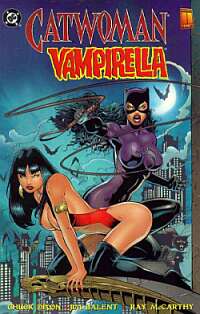 This is, very clearly, a parody of the superhero genre, playing with the conventions of secret identities, powers, merchandising and so on. The part of Spooky, one of the CoG members who is a woman masquerading as a male superhero, looks to have been written for Michelle Yeoh – one move is described as “a famous maneuver of renowned Hong Kong actress Michelle Khan — hint, hint” which puts Waters several years ahead of Hollywood in recognising her talents.
This is, very clearly, a parody of the superhero genre, playing with the conventions of secret identities, powers, merchandising and so on. The part of Spooky, one of the CoG members who is a woman masquerading as a male superhero, looks to have been written for Michelle Yeoh – one move is described as “a famous maneuver of renowned Hong Kong actress Michelle Khan — hint, hint” which puts Waters several years ahead of Hollywood in recognising her talents.
It is perhaps a little too light-hearted for the likes of Tim Burton, and somebody such as Sam Raimi would have been a better fit. Outside of Selina, there’s not much characterisation, but it’s still undeniably a fun script to read, with any number of scenes – not least the finale – that leap off the page into the imagination.
Subsequently, Selena Kyle vanished from the Ashley Judd version of the story, being replaced by a character called Patience Price – see here for a review of a 2002 script. However, the latest word on the Halle Berry version seems to be to toss everything out: “We aren’t keeping anything from Catwoman except the original idea: the character,” said slated director Pitof in an interview. Odds are that it will be a very different film from Waters’ script. And that’s probably a shame.
Brent Friedman: Tomb Raider
“Lara takes a few steps back, runs and leaps to the first pillar, pulling herself up on top. A tall flame ignites from the top center of the pillar! Instinctively, Lara backflips, executing a half twist in midair as she lunges back for the ledge”
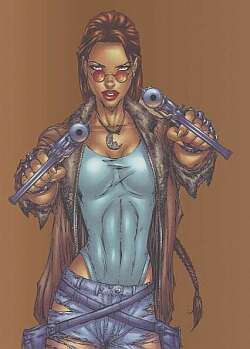 Few films had as twisted a path to the screen as Tomb Raider. [For a three-part history of some of the rumours since August 1997, see here, here, and here] Friedman’s was among the first – and certainly first publicised – attempts at a script, on which Patrick Massett, John Zinman, Akiva Goldsman, Luc Besson, and Steven E. DeSouza later tried their hands. Both Friedman and DeSouza had experience in transforming games to movies (Mortal Kombat and Streetfighter II respectively), but neither received credit for the final version.
Few films had as twisted a path to the screen as Tomb Raider. [For a three-part history of some of the rumours since August 1997, see here, here, and here] Friedman’s was among the first – and certainly first publicised – attempts at a script, on which Patrick Massett, John Zinman, Akiva Goldsman, Luc Besson, and Steven E. DeSouza later tried their hands. Both Friedman and DeSouza had experience in transforming games to movies (Mortal Kombat and Streetfighter II respectively), but neither received credit for the final version.
Friedman’s script, dated 17th July 1998, is pretty lacklustre and cliched; reports suggest he was caught between the demands of Paramount Pictures and Eidos Interactive, and as a result ending up compromising away any originality and imagination. Part of the problem was that of all the producers and executives involved, only one had actually played the game. This might explain the opening sequence in which both Lara’s parents are killed in a Himalayan air-crash, a radical deviation from the game mythos.
The McGuffin here is a map which points the way to El Dorado, the lost city of the…er, Incas? Aztecs? Mayans? Atlantans? Lara is pitted against Malvern, an Australian who also, in one of the film’s eye-rolling character traits, owns a whaling ship, so must be the bad guy. Lara battles him over a secret treasure capable of transforming base metals – in a twist, it’s used to make plutonium rather than gold.
The script bips from Tibet to Curacao, then settles down in Peru, before a finale in the Pacific, where Lara’s actions are hardly ecologically sound, and kinda contrast with the “villainous aquatic mammal killer” theme. Mind you, there’s something mildly sadistic about this Lara: at one point she shoots two rivals with tranquilizer darts, then covers them in honey and leaves them to the fire ants.
 Once they enter the El Dorado complexes, the script reads like a description of levels from the game, with levers to pull, gaps to jump, tunnels to swim through, and keys to rooms located in other places. It’s hard to see how this could have been brought to the screen without feeling like you were watching someone playing the game. In addition, the trick used to locate an entrance is a painfully direct steal from the textbook of Dr. Jones – as is the massive, rolling boulder that forms one of the traps inside.
Once they enter the El Dorado complexes, the script reads like a description of levels from the game, with levers to pull, gaps to jump, tunnels to swim through, and keys to rooms located in other places. It’s hard to see how this could have been brought to the screen without feeling like you were watching someone playing the game. In addition, the trick used to locate an entrance is a painfully direct steal from the textbook of Dr. Jones – as is the massive, rolling boulder that forms one of the traps inside.
Interestingly, one element that survived to the final movie is a fight which turns out to be a training session, in which her Tibetan monk mentor, Karak, resembles Clouseau’s Cato. The script is also heavily gadget-laden, making Lara come across like some Jane Bond, rather than someone who is all the secret weapon she needs. Overall, it’s not likely to grab the viewer by the throat, and would likely have failed to satisfy game fans or casual theatre-goers. However, it’s not much worse than the one eventually used – let’s hope the upcoming sequel, Cradle of Life, addresses this weakness, perhaps the most common one seen in game-to-movie conversions.
Postscript: I was also going to include William Gibson’s script for Alien III here, but after discovering that movie went through no less than ten writers, think it deserves an entire article on its own, covering the horde of different versions available. Don’t hold your breath though…




